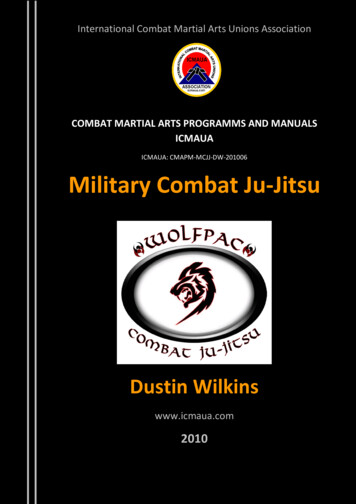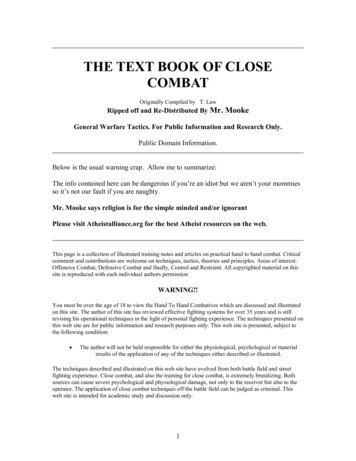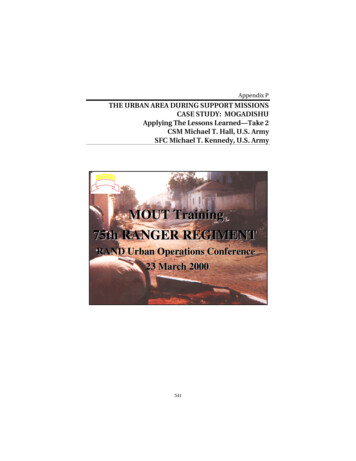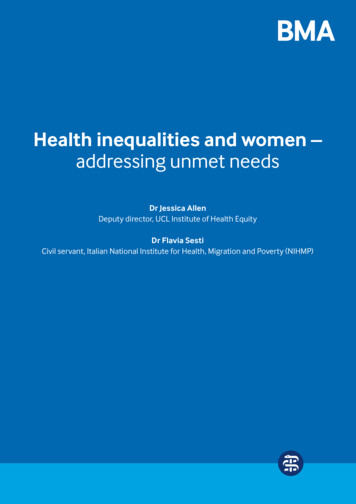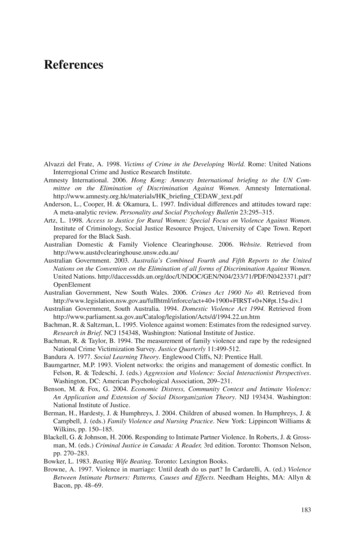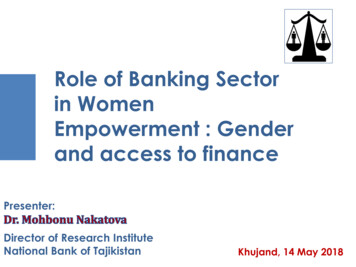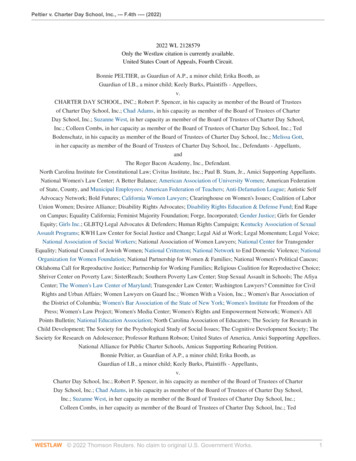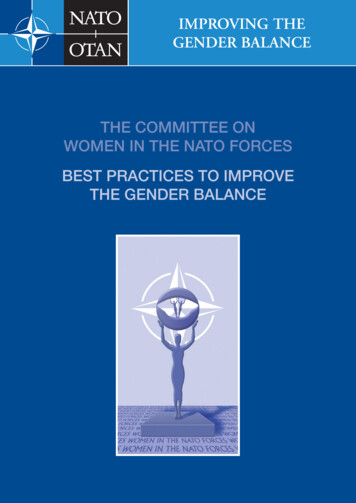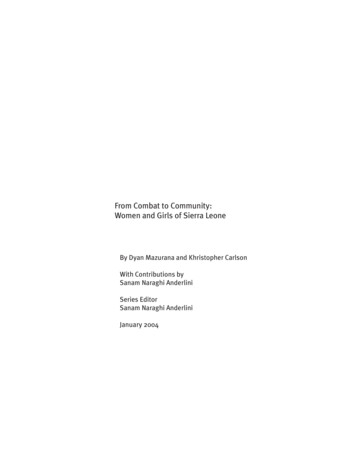
Transcription
From Combat to Community:Women and Girls of Sierra LeoneBy Dyan Mazurana and Khristopher CarlsonWith Contributions bySanam Naraghi AnderliniSeries EditorSanam Naraghi AnderliniJanuary 2004
WOMEN WAGING PEACE is a program of Hunt Alternatives Fund thatadvocates for the full participation of women in formal and informal peaceprocesses around the world.THE POLICY COMMISSION is conducting a series of case studies todocument women’s contributions to peace processes across conflict areasworldwide.Policy CommissionDirectorSanam Naraghi AnderliniAssociate DirectorElizabeth PowleyProgram AssociateCamille Pampell ConawayHunt Alternatives FundChairAmbassador Swanee HuntExecutive DirectorSarah GaugerSenior Vice PresidentAmbassador Hattie peace.netISBN Number 1-932679-02-2 Hunt Alternatives Fund. 2004. All rights reserved.
TABLE OF CONTENTSAcknowledgementsiAbout the AuthorsiProject BackgroundiiKey Findings and Recommendations1Executive SummaryWomen and the WarSoldiers and “Wives,” Cooks and SpiesDisarmament and Demobilization 1998-2000Qualifications for EntryWomen and Girls in the MarginsRising to the Challenge: Women’s Campaign for PeaceCaring for Ex-Combatants: Women’s Contributions to aleAssumptionsMethodologyDefinitionsPeace ProcessesDisarmament, Demobilization, and Reintegration DDRGender66777788Part 1: The Transition from War to PeacePre-Colonization to IndependenceCold War to Civil WarViolent Conflict and the Rise of the Civil Defense ForcesWomen and Girls in Fighting ForcesWomen and Girls as Full Members of the CDF“Wives” of RUF Commanders in Camps and Command StructureThe Role of Women in the Peace ProcessWomen Tipping the Balance Toward Peace101010111212131516Part 2: The Role and Experiences of Women and Girls in DDRDDR Design and ImplementationObstacles to the Participation of Women and Girls in Formal DDRIn the Disarmament and Demobilization PhasesIn the Reintegration PhaseExpanding the Safety Net: Women’s Contributions to ReintegrationAt the Community LevelAt the National Level1818191922222324Conclusion: The Centrality of Gender Perspectives to DDR26Endnotes28Appendix 1: Methodology34Appendix 2: List of Acronyms36Appendix 3: Bibliography37
ACKNOWLEDGEMENTSAlthough many individuals contributed expertise and insight to this report, the analysis and findingsreflect the perspective of the authors alone.We wish to acknowledge and extend our thanks to our colleagues in Sierra Leone: Shellac Davies,Maurice Ellis, Michel Kamara, Philip Kamara, Binta Mansaray, Donald Robertshaw, and Keith Wright.We would also like to thank Dorene Martinez, who conducted follow-up research in 2003.The following individuals allowed us to interview them, shared their insights, read, and commented ondrafts of this paper, and/or provided support to the project: Ester A’Kanu, Memunatu Bangora, AmyBangura, Roisin de Burca, Florian Fichtl, Cynthia Kallay, Fatta Kamara, Ramatu Sama Kamara, SamuelKamara, Daniel Sahead Karoma, Kees Kingma, Stephanie Kuttner, Olayinka Laggarh, Alfred Lansana,Jean Lieby, Jane Mansbridge, Francis Murray, Amie Passay, Antonio Piccoli, Caleb Rossiter, VictoriaSalinas, Foday Sawee, Ibrahim Sesay, M. Sylvester, Glenis Taylor, Richard Thoronka, Samuel Turner,Catherine Wiesner, and Ibrahim Yoffenddeh. There were many others who shared their perspectives butpreferred to remain anonymous.Finally, the following individuals at Women Waging Peace and Hunt Alternatives Fund made possible thepublication of this report: Sanam Anderlini, Joelle Balfe, Mari Barrera, Camille Pampell Conaway, CherylFoley, Carla Koppell, Elizabeth Powley, Jessica Ratey, Jan Smith, and Roxane Wilber. And special thanksare owed to the chair of Women Waging Peace, Swanee Hunt.About the AuthorsKhristopher Carlson is a research specialist at the University of Montana in Missoula. His areas of expertise include child soldiers, particularly girls and young women, in armed conflict and in post-conflictreconstruction. Mr. Carlson has co-authored several articles on these topics, including “Girls in FightingForces and Groups: Their Recruitment, Participation, Demobilization, and Reintegration” Journal ofPeace and Conflict. He was a contributing author to the United Nations Secretary-General’s study,Women, Peace and Security.Dyan Mazurana is a senior researcher with the Feinstein International Famine Center and a researchscholar and faculty member at the University of Montana in Missoula. She is a lead researcher on andauthor of the United Nations Secretary-General’s Study, Women, Peace and Security. Dr. Mazurana haswritten and developed training materials regarding gender, women’s human rights, armed conflict, andpost-conflict reconstruction for civilians, police, and military peacekeepers involved in UN, NATO, andregional peacekeeping missions.i
PROJECT BACKGROUNDWars and internal conflicts do not end simply with the signing of peace agreements. To avoida resurgence of violence, it is necessary to develop and support measures for strengthening thegovernance, security, justice, and socioeconomic capacities of a state. This is a complex task inany society, but daunting in post-conflict situations. While the international community can provide assistance and valuable resources, the local population, which has no “exit strategy,” has thegreatest commitment to building sustainable peace. It is therefore essential to draw on the assets,experiences, and dedication at the local level and among all sectors of society. One sector oftenoverlooked and underestimated is women. In most post-conflict societies women are more than50 percent of the population and are actively engaged in peace building while addressing the basicsurvival needs of their families and communities. Yet they are often portrayed as passive victims,and little regard is given to their actual and potential roles in fostering security.In October 2000, for the first time in its history, the United Nations Security Council acknowledged that women have a key role in promoting international stability by passing Resolution 1325on women, peace, and security. It called on all parties to ensure women’s participation in peace processes, from the prevention of conflict to negotiations and post-war reconstruction. The WomenWaging Peace Policy Commission was established to examine peace processes with a particularfocus on the contributions of women. Drawing on qualitative field-based research and quantitativesurvey data, “From Combat to Community: Women and Girls of Sierra Leone” assesses how consideration of gender issues can improve disarmament, demobilization, and reintegration (DDR)processes and documents the contributions of women in official and civil society-based reintegration programs.ii
F R O M C O M B AT TO C O M M U N I T Y: W O M E N A N D G I R L S O F S I E R R A L E O N EKEY FINDINGS AND RECOMMENDATIONSKey Findings1. Throughout the conflict, women led civil society peace efforts. In 2002, as the country faced the breakdownof the 1999 Lomé accords, women were pivotal in galvanizing mass demonstrations that led to the end of thewar.2. Contrary to official reports, women played a military role in the pro-government Civil Defense Forces and inthe rebel movement.3. Female ex-combatants from all forces were significantly underrepresented in official disarmament, demobilization, and reintegration (DDR) programs.4. Women are playing a significant but unacknowledged role in the reintegration of former fighters, filling manygaps in official programs.Recommendations1. When planning DDR, international actors, including the UN, multilateral organizations, donor governments,and national governments, must: ensure the participation of women during all stages of negotiation; assume that women are part of the fighting forces and be aware that, where children are present,10 to 33 percent may be girls; recognize the initial estimated number of fighters provided by military forces may be low, andthus be prepared to increase resources to ensure effective programs; and extend the definition of combatant to include those who were part of a “regular armed force inany capacity, including but not limited to cooks and messengers.and girls recruited for sexualpurposes.”—in accordance with existing norms followed by the UN Children’s Fund (UNICEF)and outlined in the UN Secretary-General’s study, Women, Peace and Security (2002).2. During disarmament and demobilization, implementing organizations should: accept females even when unaccompanied by men; and develop parallel systems for the demobilization of women and girls by:–offering women the choice to enter care centers with their children or to remain with their malecolleagues and counterparts; and– ensuring there are facilities to separately house girls and boys without parents.3. In reintegration, donors should ensure that: local organizations and communities working with former combatants are direct beneficiaries ofresources from official reintegration and rehabilitation programs; income-generation and job-creation programs are created to provide employment for ex-combatants and members of communities into which they are returning; and DDR programs support mothers, particularly single mothers, emerging from the fightingforces—including providing basic care for them and their children (through foster care programsor centers) to facilitate their participation in education and skills training that can help themavoid petty crime or the sex trade.1
Women Waging Peace POLIC Y CO MM I S S IONEXECUTIVE SUMMARYSierra Leone ended its national disarmament, demobilization, and reintegration (DDR) program inDecember 2003. Since the program began in 1998,72,500 former combatants have been demobilized,including 4,751 women (6.5 percent) and 6,787 children (9.4 percent), of whom 506 are girls.1 From theoutset, there was some recognition that women andchild soldiers made up a significant portion of theforces.2 In theory, the DDR process was designedto include them. But while the program was effective in reaching out to male combatants, ultimatelywomen and children were underserved. Despite thisshortcoming, the plan has been hailed as a success anda model upon which other DDR processes could bebased.These DDR programs have also failed to supportcivilian populations faced with the reality of reintegrating former fighters. Instead, in communitiesacross Sierra Leone, women as individuals and ingroups have taken on the responsibility of assistingformer combatants as they return to civilian life. Butthey receive little or no support from the national andinternational programs established to ensure successfulreintegration.Women and the WarIn March 1991, the Revolutionary United Front ofSierra Leone (RUF/SL), led by former Sierra LeoneArmy (SLA) corporal Foday Sankoh, invaded SierraLeone from Liberia. Violence against women andchildren, and general terror in rural and urban centersquickly became cornerstones of the RUF movementand were encouraged by its leadership. But as thewar escalated, women and girls reported atrocitiescommitted by forces on both sides. Preyed uponby the RUF and SLA, local civilians in many areastransformed traditional hunting societies, such as theKamajors, into pro-government militias known asCivil Defense Forces (CDF). These militias gainedprominence with the armed activities of the Kamajorsin the eastern and southern provinces and the rise ofthe Gbethis in the north, among others. Throughoutthe war years, the government endorsed the CDF,providing them with resources, including weapons.Soldiers and “Wives,” Cooks and SpiesWomen and girls were present in large numbers inpro-government and rebel forces and were involved ina variety of activities. In the survey of 50 female ex-2combatants (ranging in age from 10 to 35) conductedfor this study, almost all stated “abduction” as theirmeans of entry; one third stated that they had fighting experience; nearly half indicated that they receivedweapons training; one fifth described themselves asspies; and more than half indicated that in addition toperforming other duties, they were forced to be captive “wives.” On average, they were 12 years old whenthey entered the forces.Despite denials by government officials, girls andyoung women played an integral role in the CDF.They were spies, commanders, and frontline fighters;some were herbalists, meant to supply fighters withmagic potions for invulnerability. Others were cooks,medics, and spiritual leaders. They witnessed brutalrituals and suffered significant sexual abuse.Women and girls also made up a large part of rebelRUF forces. Many served as captive “wives” of commanders and were responsible for distributing weapons, food, and loot confiscated from village raids. Theycommanded fighting forces known as small boys unitsand small girls units; many were also involved in themutilation and murder of civilians. In camps, commanders’ “wives” sometimes used their control overfood and loot to prevent young boys and men fromabusing girls.In sum, the experience of women and girls in thefighting forces was complex. They were captives anddependents, but they were also involved in the planning and execution of the war.Disarmament and Demobilization 1998-2000The Sierra Leone government and international partners, including the Economic Community of WestAfrican States Monitoring Group and the UnitedNations, conducted disarmament and demobilizationin three phases between 1998 and 2000. Reintegrationprograms continued through 2003. At the start ofthe program, the estimated number of combatantswas 45,000, of which 12 percent was presumed tobe women.3 At its completion, over 72,000 had beendemobilized, indicating that the preliminary estimates of force size were inaccurate. As 84 percentof the demobilized were adult men, the programwas effective in reaching out to this segment of thepopulation. Since just 6.5 percent of the demobilizedwere women, however, it seems likely that thousands
F R O M C O M B AT TO C O M M U N I T Y: W O M E N A N D G I R L S O F S I E R R A L E O N Emore fighters, particularly women and girls, were notreached by the official process.4Qualifications for EntryAdults (18 years and older) were eligible for entryinto the program by presenting a weapon at any ofthe official reception centers across the country. Theywere asked questions and required to disassemble andreassemble a gun, usually an AK-47, as a prerequisitefor participation. In Phases I and II, wives and dependents were not eligible for entry.In Phase III, a group could bring in a weapon. Late inthe program, as men complained about their inability to sustain their families, “wives” were permittedto apply for microcredit. For a woman to access theloans, however, she had to be present with a man whowas willing to identify her as his wife. No womancould claim benefits alone, regardless of the numberof children in her care. For many abductees forcedinto “marriage,” there was no means of escaping theircaptors. But some senior DDR officials did not consider this important. “Even if they were raped andabducted,” said one unnamed official in a 2002 interview, “70 percent want to be with their husbands.”Officially, those under 18 were not required to present a weapon to enter DDR. However, there waswidespread inconsistency among the UN, government officials, and NGO staff on whether childrenwere required to turn in weapons. The majority of girlfighters interviewed for this study, including thosewho passed through the DDR process, stated that theweapons test was repeatedly administered to children.Women and Girls in the MarginsNearly 7,000 children participated in official demobilization programs,5 but estimates suggest that therewere as many as 48,216 children in the forces. Thus,there is significant disparity between the numberof children, particularly girls, presumed to be in theforces and the numbers that entered the DDR programs (see table).Table 1: Estimated Number for Total Forces, ChildSoldiers, and Girl Soldiers40ForceTotalChild otal137,86548,21612,056In the survey referenced earlier, half of the women andgirls had not gone through official disarmament anddemobilization. Their experiences highlight a numberof gaps in the process:1. Forty-six percent cited not having a weapon as abarrier for entry into the program. Many womenin the CDF were ordered to hand in their weaponsprior to demobilization, then were left behind astheir male colleagues were transported to assemblycenters. Others indicated that their guns were takenaway by their commanders and handed to malefighters. Many who were not “primarily” fightershad used weapons from a communal source but didnot possess guns themselves.2. Twenty-one percent feared reprisals from opposingforces at the centers and so avoided the process.3. Others reported feeling unsafe among the men andthus stayed away from the sites.4. Many had no knowledge of the program or feltthere was nothing to gain by participating.5. Little was done to reach out to women and girls inthe CDF, as it was incorrectly assumed that thesewere male-only units.According to local reports since the conclusion of thedisarmament and demobilization components of theofficial program, some female ex-combatants haveturned to prostitution and petty crime for survival.3
Women Waging Peace POLIC Y CO MM I S S IONWith no hope of receiving assistance from the children’s fathers, their own families, or the state, some areturning to violence. In 2002, social workers observedthat young women, particularly those with children,were instigating riots in urban centers. Some youngwomen fighters have reportedly crossed borders tojoin armed groups across the region.Rising to the Challenge:Women’s Campaign for PeaceFrom the early days of the war, women in rural andurban centers mobilized to protest the atrocities andcall for peace. In May 2000, with the RUF floutingthe 1999 Lomé accords, a group of elderly womencame together, demanding a meeting with Sankoh.On arriving at the RUF compound, they were mistreated and insulted. Frustrated, the women tried adifferent tactic. They collectively hitched up theirskirts, bent over, and bared themselves to Sankoh andhis coterie. In Sierra Leone, such an action by womenis the worst curse that can be brought upon anyone.The news had a galvanizing effect on Sierra Leoneans.They had an obligation to uphold the women’s honorand support the curse. But the women’s actions alsogave people the courage to stand up to the RUF.Coinciding with the arrival of the new UN missionand British Special Forces, the women’s protest andsubsequent public demonstrations, were pivotal in thestruggle for peace, culminating in Sankoh’s arrest.Caring for Ex-Combatants:Women’s Contributions to ReintegrationAcross Sierra Leone, women as individuals and ingroups have been critical to reintegrating formercombatants, particularly those excluded from officialprograms. Some women whose children were killedhave opened their homes to former child soldiers.Others have set aside their own suffering and offeredhelp, believing that, “If left abandoned, the child excombatants would have nothing positive to do andwould prove a threat to a fragile peace.”6In the study survey, 55 percent of respondents indicated that women in the community played a significant role in helping them reintegrate. This was higherthan responses for assistance given to them by traditional leaders (20 percent) or international aid workers(32 percent). They said community women providedguidance, shared meager resources, and, perhaps mostimportant, helped facilitate their skills training and4education by providing childcare, clothes, and food.Women’s organizations have also provided models formany of the female ex-combatants; over 65 percentof respondents said that they would like to join suchorganizations, which they see as offering practicalassistance.Nationally, the Forum for African WomenEducationalists and the Progressive Women’sAssociation are the main organizations active inreintegration programs. Among local organizations,Caritas-Makeni, affiliated with the Catholic Churchand operating in central Sierra Leone, has developeda foster care program for young mothers, enablingthem to attend school while their children are tended.Caritas-Makeni also offers counseling and programson health and alternative income generation for thosewho have entered the sex trade.Among international actors, the UN Children’s Fund(UNICEF) and the US Agency for InternationalDevelopment (USAID) offer strong models for working with local groups and reaching former combatants excluded from the national programs. UNICEFhas an innovative program of providing resources toschools that accept former child combatants. In addition, UNICEF, with the support of USAID, runstraining centers that offer mothers childcare and food.A number of their programs combine vocational training with basic literacy and numeric skills. Non-traditional trades such as welding, carpentry, and housebuilding are among those taught to women. Fortynine percent of survey participants said such training,as well as education, are critical in facilitating theiradjustment to civilian life.ConclusionSierra Leone’s DDR process failed women and girls.As many were classified as “dependents” only, theirreal experiences were not acknowledged, and theywere precluded from receiving the benefits provided to“combatants.” The assumption that women and girlswere victims only, with no role in either the executionof war or the building of peace, is proving detrimentalto their future, with potentially negative consequencesfor the country’s recovery and the region’s security.First, despite their horrific experiences in the war,women and girls have shown tremendous agency andinitiative. Even during their captivity, those in the
F R O M C O M B AT TO C O M M U N I T Y: W O M E N A N D G I R L S O F S I E R R A L E O N Eforces regained some control of their own lives bydeveloping skills to ensure their survival and strategies to protect others. Yet when the DDR programwas implemented, there was virtually no recognitionof the multiple roles women played or the skills theyhad gained. Many have ambitions for education andindependence. They feel tremendous responsibility fortheir offspring and aspire to give them a better future.By being treated as passive victims, they are againstripped of their sense of self-worth and dignity.Second, women’s exclusion from official programswill have significant social consequences, including poverty, crime, prostitution, and an increase inHIV/AIDS. Moreover, the exclusion of single mothers means the exclusion of their children—and thusanother generation of unskilled, marginalized youth.Third, in the same way that disaffected male youthsand ex-fighters might lead rebellions, form militias,or join other guerilla groups, so can women and girls.As the 2002 riots and female militia activities indicate, some have already taken up violence. Withoutsupport, these young mothers have little to lose fromresorting to armed activity as a means of survival.Drawing on qualitative field-based research and quantitative survey data, this study assesses how a genderperspective can improve formal disarmament, demobilization, and reintegration (DDR) programs anddocuments women’s contributions to official and civilsociety-based initiatives.Endnotes1Bradley, Sean, Massimo Fusato, and Philippe Maughan. “SierraLeone: Disarmament, Demobilization and Reintegration (DDR).”Ed. P.C. Mohan. Findings Africa Region 81. Washington, DC: TheWorld Bank, 2002, 1, 22 October 2003 fob81.pdf ; Women’s Commission forRefugee Women and Children. Precious Resources: Adolescents in theReconstruction of Sierra Leone. New York: Women’s Commission,2002, 46; Sierra Leone. National Committee for Disarmament,Demobilization and Reintegration. Statistical data provided to theauthors. Freetown: NCDDR, 2002.2Estimates indicate that up to 50 percent of fighters in rebel forceswere children and some 10-30 percent of force members werewomen.Malan, Mark, et al. Sierra Leone: Building the Road to Recovery.Pretoria, South Africa: Institute for Strategic Studies, 2003, 25.34Sierra Leone, NCDDR; Women’s Commission 46.5Women’s Commission 46.6Shellac, Davies, personal interview, August 2002.Finally, local community efforts, informal networks,and organizations—primarily led by women—providecritical support for former combatants. Women’s commitment to rehabilitating and coexisting with formerfighters is a matter of basic survival for themselves andothers. Unlike the international community, they haveno exit strategy. If they fail, violence returns to theirdoorsteps. At the same time, local groups are underimmense pressure. They have meager resources, theirwork is rarely acknowledged in official processes, andthey receive only limited assistance from the international community. Supporting the work of thesewomen is a cost-effective and essential ingredient forensuring sustainable reintegration.5
Women Waging Peace POLIC Y CO MM I S S IONINTRODUCTIONIn December 2003, Sierra Leone ended its official disarmament, demobilization, and reintegration (DDR)program. From the time of its initiation in 1998,72,500 former combatants passed through the program, including 4,751 women (6.5 percent) and 6,787children (9.4 percent), of whom 506 were girls1. Fromthe outset there was recognition of the large presence of child soldiers (up to 50 percent of fighters inrebel forces were believed to be under 18) and women(estimates ranged between 10 and 30 percent) amongthe various forces, so the program was in principle,designed to include them. At completion, however,while the program was noted for its effective outreach to male combatants, women and children wereunderserved. Despite this significant shortcoming,the program has been hailed as a success by the UN,the World Bank, and others, and a model upon whichother DDR processes could be based.2The DDR program also failed to provide support tocivilian populations faced with the reality of reintegrating former fighters. Instead, women as individualsand in groups took on the responsibility of assistingthese fighters, particularly the children and youthamong them, as they returned to civilian life. Themajority of these community-based efforts, however, received little or no aid or recognition from thenational and international programs established toguarantee not just successful demobilization, but ultimately effective reintegration and rehabilitation.This report revisits the Sierra Leone conflict andpeace process from the perspective of women.Drawing on field-based interviews and data, it outlines the diverse roles played by women and girls inthe war and highlights the importance of women’sactivism for peace. This study presents key findingsof the experiences of women and girls in the DDRprogram, focusing on obstacles to access, entry, andfull participation. It documents women’s individualand collective contributions to the reintegration offighters, concluding with an analysis of the importance of a gender perspective to DDR efforts andpractical recommendations to support the development of such programs.Outlined here are the rationale for this study, assumptions of the research, an explanation of methodology,and the working definitions that frame this report.RationaleLimited research has been conducted to assess DDRprograms’ ability to respond to the experiences ofwomen and girls within fighting forces, in SierraLeone or elsewhere.3 Still less is known about howprograms that do or do not address gender considerations may contribute to or hinder peacefultransitions. Drawing on the Sierra Leone conflict(1991-2000) this report uses quantitative and qualitative methods and gender analysis to document andexamine women and girl ex-combatants’ roles andexperiences within the forces and official DDR processes.aIn addition to a lack of information on the experiences of women and girls in official DDR programs,knowledge is scarce regarding the contributions thatwomen make to official and community-based DDRprocesses. As conflicts increasingly involve civilianpopulations, women are more and more often calledupon to “unofficially” assist in demobilizing and reintegrating ex-combatants, especially child soldiers. InSierra Leone, children constituted half of some of thefighting forces; up to one third of these were girls.4This study, therefore, also documents women’s previously unrecognized actions to strengthen official andcommunity-based DDR, assist ex-combatants, andcontribute to peace building within Sierra Leone andthe region.Results presented in this study draw in part on data collected under a grant from the Canadian International Development Agency (CIDA)and the International Centre for Human Rights and Democratic Development, “Girls in Militaries, Paramilitaries, Militias, and ArmedOpposition Forces” (Montreal: Rights and Democracy, 2003). Principle investigators for the CIDA grant were Dyan Mazurana and SusanMcKay, Professor of Women’s Studies, University of Wyoming, USA; the full results are presented in the forthcoming book, Where Are theGirls? Girls in Fighting Forces in Northern Uganda, Sierra Leone, and Mozambique: Their Lives During and After War (Montreal: Rights andDemocracy).a6
F R O M C O M B AT TO C O M M U N I T Y: W O M E N A N D G I R L S I N S I E R R A L E O N EAssumptionsThis study rests on the assumption that effectiveDDR processes are critical for achieving sustainablepeace. Further, it presupposes that it is insufficient toprioritize the disarmament and demobilization elements alone at the expense of the reintegration component. Finally, it acknowledges that the burden ofreintegration and longer-term rehabilitation is largel
Khristopher Carlson is a research specialist at the University of Montana in Missoula. His areas of exper-tise include child soldiers, particularly girls and young women, in armed conflict and in post-conflict reconstruction. Mr. Carlson has co-authored several articles on these topics, including "Girls in Fighting

